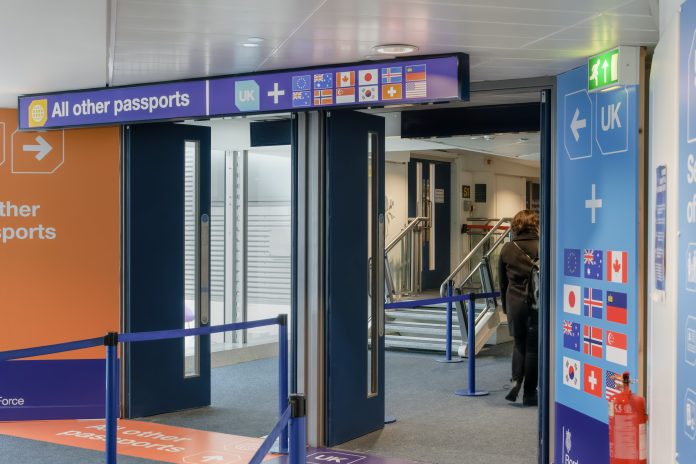Richard Gutsell, Client Director, Atkins, explores how we can transform UK borders in a post-Brexit world
When we talk about borders, we’re referring to the physical boundary of a country over which people and goods move. Barriers that safeguard nations, that are the gateways to imports and exports, and that are located across airways, seaways, railways and roads. Concerns – and much discussion – of borders is currently centred on the UK’s departure from the European Union. But beyond the legislation, could this be an opportunity to harness new technologies, improve the passenger journey and support seamless trade? And beyond that, can we use this opportunity to have borders boost education, tourism and businesses, while also ensuring that we’re all safe?
If we get it right, the borders of the future have the potential to transform the UK. But there are a number of technological and logistical issues that need to be tackled first.
Expecting the unexpected
At airports, all passengers should move through the building in the same general direction. First by checking-in and dropping hold baggage, then on to security checks, followed by a quick browse in duty-free before heading to the gate ready to board their flight. However, people are unpredictable and don’t always follow the intended passenger flow. They may drop off their suitcases and then realise there was something essential they really need now. Or perhaps they’ve made it through the final gate checks before remembering they’d agreed to meet a friend outside a shop, not at the gate.
It’s these exceptions that have the potential to make any system fall down, and that necessitates extra complexity to ensure they’re designed to be foolproof. With the right experience and understanding of context, we can engineer-in the right processes to deal with that complexity. But this can only be done by having a deep understanding of the physical environment passengers will occupy; and subsequently, how digital technologies can enhance these spaces. A good example of this is the need to “delogging”, all too often people need to exit the airside lounge to pick up something they have forgotten, to drop an extra bag, or any number of reasons. The system needs to be able to allow the passenger to exit and enter airside (and some do it multiple times, legitimately!), critically that they match the identity of someone who entered previously and has permission to be in the UK, and flag any number of exceptions to that process that may indicate risk.
Digital twin uptake
There are many emerging tools that can help smooth the journey of people and goods through borders, and one of these is the digital twin. This is a repository of information that precisely mirrors a physical asset – at its most mature stage, a digital copy with real time operational information.
Already in use across the transport and energy sectors, from trains to turbines, a digital twin can assess the value, performance and depreciation of assets. In turn, this information can help inform decisions about asset maintenance, operational expenditure and investments, to support improved operations. So, within an airport security context, that could mean the customer journey through security gets mapped out as a digital design, with further intelligence – such as metadata gathered from sensors that monitor passenger throughput – layered over it.
This data would give us the ability to model a multitude of different stress scenarios and model what interventions might be made to see what effect they have. With real-time data feeding into the digital twin and inputs from predictive sources such as weather, landing times and passenger numbers, it is possible to predict the approach of those stress scenarios and make earlier interventions.
Not enough collaboration
Introducing more intelligence can help security agencies make more informed decisions and manage risk better, but there are obstacles. One is that different agencies’ systems are not always able to share data. This is something we must tackle. A multitude of government agencies have a presence at our ports and airports – so shouldn’t we be seeing this as an opportunity to replace legacy technology with newer innovations that can interface better and share intelligence? And an opportunity to build on national data standards and international agreements, leading to increased international trust. This, could, in turn, prompt a move upstream towards earlier intervention, based on determining risk. By having a richer picture of people and goods being moved, our borders agencies are better informed to take earlier action against criminal activity.
Climate change versus market growth
Meeting Net Zero targets must be front and centre to our thinking when it comes to any industrial development. One of the big factors for our industry will be passenger and cargo journeys. Prior to COVID 19 air passenger transport was steadily rising 6% each year and shipping cargo at 4%. So, it’s critical that these journeys are made more efficient. Harnessing and accelerating green technology is fundamental to growing the economy in tandem with carbon reduction, we must invest now for long term change, make our borders the centre of innovation in carbon efficiencies.
Using what we’ve got
Much of the technology that can help us address these obstacles and make the UK’s borders the most secure – and also the smoothest – already exists. So, it’s not a question of waiting for new inventions but instead, it’s about integrating it with the physical barriers and processes at our borders. What we need are new strategies that bring together digital and physical infrastructures, so they work in harmony to mutually support each other, and create borders of the future that are smooth, but also secure.





![Europe’s housing crisis: A fundamental social right under pressure Run-down appartment building in southeast Europe set before a moody evening sky. High dynamic range photo. Please see my related collections... [url=search/lightbox/7431206][img]http://i161.photobucket.com/albums/t218/dave9296/Lightbox_Vetta.jpg[/img][/url]](https://www.openaccessgovernment.org/wp-content/uploads/2025/04/iStock-108309610-218x150.jpg)





